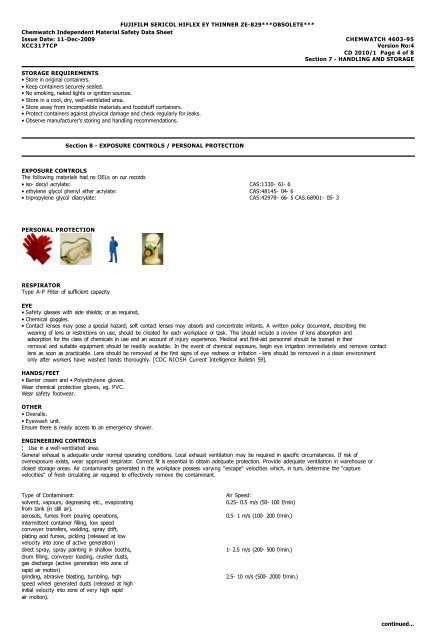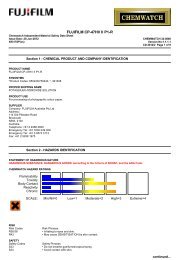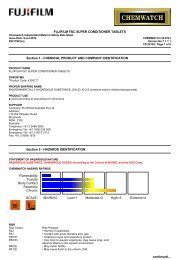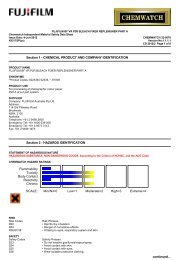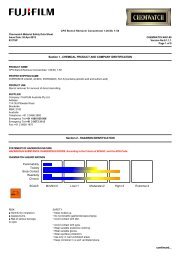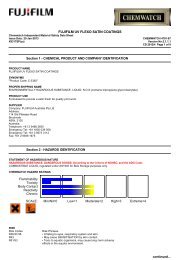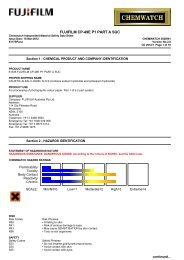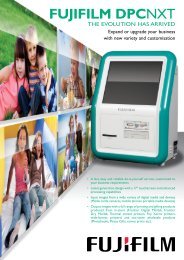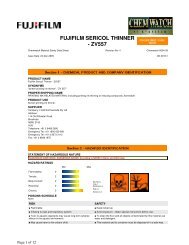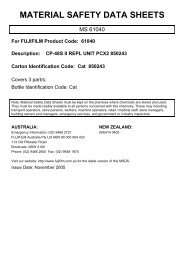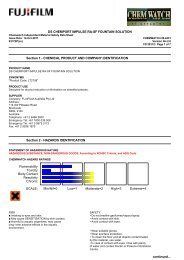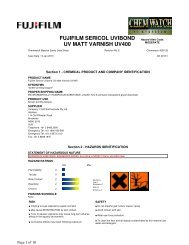Chemwatch MSDS Print - FUJIFILM Australia
Chemwatch MSDS Print - FUJIFILM Australia
Chemwatch MSDS Print - FUJIFILM Australia
Create successful ePaper yourself
Turn your PDF publications into a flip-book with our unique Google optimized e-Paper software.
<strong>FUJIFILM</strong> SERICOL HIFLEX EY THINNER ZE-829***OBSOLETE***<strong>Chemwatch</strong> Independent Material Safety Data SheetIssue Date: 11-Dec-2009 CHEMWATCH 4603-95XCC317TCPVersion No:4CD 2010/1 Page 4 of 8Section 7 - HANDLING AND STORAGESTORAGE REQUIREMENTS• Store in original containers.• Keep containers securely sealed.• No smoking, naked lights or ignition sources.• Store in a cool, dry, well-ventilated area.• Store away from incompatible materials and foodstuff containers.• Protect containers against physical damage and check regularly for leaks.• Observe manufacturer's storing and handling recommendations.Section 8 - EXPOSURE CONTROLS / PERSONAL PROTECTIONEXPOSURE CONTROLSThe following materials had no OELs on our records• iso- decyl acrylate: CAS:1330- 61- 6• ethylene glycol phenyl ether acrylate: CAS:48145- 04- 6• tripropylene glycol diacrylate: CAS:42978- 66- 5 CAS:68901- 05- 3PERSONAL PROTECTIONRESPIRATORType A-P Filter of sufficient capacityEYE• Safety glasses with side shields; or as required,• Chemical goggles.• Contact lenses may pose a special hazard; soft contact lenses may absorb and concentrate irritants. A written policy document, describing thewearing of lens or restrictions on use, should be created for each workplace or task. This should include a review of lens absorption andadsorption for the class of chemicals in use and an account of injury experience. Medical and first-aid personnel should be trained in theirremoval and suitable equipment should be readily available. In the event of chemical exposure, begin eye irrigation immediately and remove contactlens as soon as practicable. Lens should be removed at the first signs of eye redness or irritation - lens should be removed in a clean environmentonly after workers have washed hands thoroughly. [CDC NIOSH Current Intelligence Bulletin 59].HANDS/FEET• Barrier cream and • Polyethylene gloves.Wear chemical protective gloves, eg. PVC.Wear safety footwear.OTHER• Overalls.• Eyewash unit.Ensure there is ready access to an emergency shower.ENGINEERING CONTROLS¦ Use in a well-ventilated area.General exhaust is adequate under normal operating conditions. Local exhaust ventilation may be required in specific circumstances. If risk ofoverexposure exists, wear approved respirator. Correct fit is essential to obtain adequate protection. Provide adequate ventilation in warehouse orclosed storage areas. Air contaminants generated in the workplace possess varying "escape" velocities which, in turn, determine the "capturevelocities" of fresh circulating air required to effectively remove the contaminant.Type of Contaminant:solvent, vapours, degreasing etc., evaporatingfrom tank (in still air).aerosols, fumes from pouring operations,intermittent container filling, low speedconveyer transfers, welding, spray drift,plating acid fumes, pickling (released at lowvelocity into zone of active generation)direct spray, spray painting in shallow booths,drum filling, conveyer loading, crusher dusts,gas discharge (active generation into zone ofrapid air motion)grinding, abrasive blasting, tumbling, highspeed wheel generated dusts (released at highinitial velocity into zone of very high rapidair motion).Air Speed:0.25- 0.5 m/s (50- 100 f/min)0.5- 1 m/s (100- 200 f/min.)1- 2.5 m/s (200- 500 f/min.)2.5- 10 m/s (500- 2000 f/min.)continued...


